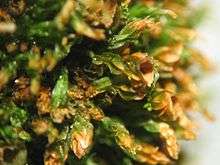Tetraphidaceae
| Tetraphidaceae | |
|---|---|
 | |
| Tetraphis pellucida | |
| Scientific classification | |
| Kingdom: | Plantae |
| Division: | Bryophyta |
| Class: | Tetraphidopsida Goffinet & Buck[1] |
| Order: | Tetraphidales M. Fleisch. |
| Family: | Tetraphidaceae |
| Genera | |
The Tetraphidaceae is a family of mosses. It includes only the two genera Tetraphis and Tetrodontium, each with two species.[2] The defining feature of the family is the 4-toothed peristome.
family Tetraphidaceae
|
| |||||||||||||||||||||||||||||||||||||||
| The classification of the Tetraphidaceae, and its phylogenetic position among the mosses.[1][3] | ||||||||||||||||||||||||||||||||||||||||
Range
_3873.jpg)
The family of moss is most commonly found in northern latitudes.[4]
Tetraphis
The Tetraphis pellucida is the most common species in the family and is usually found in deciduous forests.[4] The leaves of the Tetraphis pellucida becomes wider the colder the climate becomes, which often leads to a misclassification of the species.[4] Tetraphis geniculta is less commonly found and also appears in northern latitudes.[4] The species often times grows along side the only other species in its genera: Tetraphis pellucida.[4] Both species in the Tetraphis genera were found growing on moist sedimentary rocks and also on soil with high organic content,[4] but the genera is mostly found growing on rotting logs.[5]
Terodontium
Terodontium brownianum grows most frequently on wet and shady rocks, of either granite or sandstone.[4] The species normally grows alone but has been found growing with other bryophytes.[4] Terodontium repandum is extremely rare and has been found growing in parts of central Europe, western north America and southeast Asia.[6]
Morphology
The most notable anatomy structure in the Tetraphidaceae family is the four teeth that make up the peristome.[7] The teeth are whole, thick-walled cells which classifies the moss family as nematodontous.[7] The teeth help the plant adapt as they can sense changes in the moisture in change length.[6]
Tetraphis
The Tetraphis genera is made up of species Tetraphis pellucida and Tetraphis geniculta. The shoots on Tetraphis pellucida can be up to 1.5 cm tall and the lower leaves are often only 1 mm in length.[8] The fertile shoot tips are longer with distinct leaves while the leaves on the sterile shoot tips are more clumped together.[8] The crowded leaves of the non-fertile shoot tip may form a gemma cup.[8] The capsule, which is only about 2–3 mm in length, contains the spores used in sexual reproduction and is made up of four peristome teeth.[2] The capsule usually fruits around early summer [9] and the green, papillose spores are spread by wind.[2]
The main contrast between Tetraphis pellucida and Tetraphis geniculta is the characteristics of the seta.[10] In Tetraphis pellucida the seta is smooth and straight while in Tetraphis geniculta the seta is bent and papillose.[10] In their immature forms, it is often difficult to tell one species from another as the seta is not yet fully developed.[10]
Terodontium
The Terodontium brownianum has short, bristlelike structures that grow out of the protonemal leaves. The bristle-like structure can be up to 4 mm long and the protonemal leaves can be up to 2.5 mm long.[11] Four triangular teeth make up the egg-shaped capsules which are normally only 1 mm long.[11] The spores that the capsule produce are smooth, in contrast to the papillose spores produced by the Tetraphis genera.[2] Terodontium repandum is very similar but produces long, thin branches and the stem usually only grows to be about 2 mm in length.[11] In some cases, the a Terodontium colony is made up only of the protonemal leaves.[11] Additionally, the Terodontium genera does not have specialized asexual structures, in contrast to the Tetraphis genera.[2]
History of taxonomy
Johann Hedwig first described and named the Tretraphis genus and Tretraphis pellucida in his book Species Muscorum Frondosorum, published in 1801. [2] In 1824 Christian Friedrich Schwägrichen named the Terodontium genus.[2] The phylogeny and taxonomy of the Tetraphidaceae family, in relation to other bryophytes, have long been disputed among bryologists.[7] Some bryologist believe that there are characteristics of the family, like the thalloid protonema or the development of the peristome, that indicate that the moss is primitive and may share a common ancestor with Sphagnopsida and Andreaeidae.[7] The exact phylogeny of the family and its species continues to be discussed among bryologists.
References
- 1 2 Goffinet, Bernard; William R. Buck (2004). "Systematics of the Bryophyta (Mosses): From molecules to a revised classification". Monographs in Systematic Botany. Molecular Systematics of Bryophytes. Missouri Botanical Garden Press. 98: 205–239.
- 1 2 3 4 5 6 7 Harpel, Judith A. (2007). "Tetraphidaceae". In Flora of North America Editorial Committee (eds.). Flora of North America. 27. New York & Oxford: Oxford University Press. pp. 111–115. ISBN 978-0-19-531823-4.
- ↑ Goffinet, B.; W. R. Buck; A. J. Shaw (2008). "Morphology and Classification of the Bryophyta". In Bernard Goffinet & A. Jonathan Shaw (eds.). Bryophyte Biology (2nd ed.). Cambridge: Cambridge University Press. pp. 55–138. ISBN 978-0-521-87225-6.
- 1 2 3 4 5 6 7 8 Forman, Richard T. T. (1962). "The Family Tetraphidaceae in North America: Continental Distribution and Ecology". The Bryologist. 65 (4): 280–285. doi:10.2307/3240727. JSTOR 3240727.
- ↑ 1922-2002., Crum, Howard, (2001). Structural diversity of bryophytes. Ann Arbor: University of Michigan Herbarium. ISBN 9780962073342. OCLC 46991287.
- 1 2 "Small four-tooth moss videos, photos and facts - Tetrodontium repandum". Arkive. Retrieved 2018-04-15.
- 1 2 3 4 Shaw, Jonathan; Anderson, Lewis E. (1988). "Peristome Development in Mosses in Relation to Systematics and Evolution. II. Tetraphis pellucida (Tetraphidaceae)". American Journal of Botany. 75 (7): 1019–1032. doi:10.2307/2443770. JSTOR 2443770.
- 1 2 3 Alan, Hale. "Tetraphis pellucida" (PDF). British Bryological Society: 333.
- ↑ Webmaster, David Ratz. "Four Tooth Moss - Montana Field Guide". Retrieved 2018-04-16.
- 1 2 3 Weber, William A.; Simone, Leo D. (1977). "Tetraphis pellucida and T. geniculata: Scindulae as Diagnostic Features in Bryophytes". The Bryologist. 80 (1): 164–167. doi:10.2307/3242528. JSTOR 3242528.
- 1 2 3 4 Alan, Hale. "Tetrodontium brownianum" (PDF). British Bryolgical Field Guide: 334.